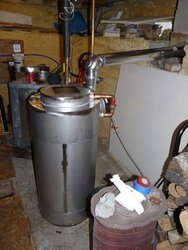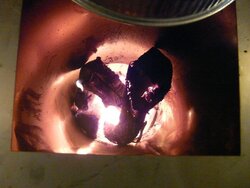I looked at a lot of boilers when I was getting ready to purchase. The Garn was a consideration. I like the idea of a wood burner and storage all in one unit. But they were to big to get into my basement without major, major renovation or putting it in a detached building and then trenching and installing underground lines. Something I did not want. I did not want my boiler in an out building. And I did not want to be digging through the ground and have all that to deal with.
Anyway, it seams with all the technology and possibilites out there, that Garn or someone else would take the same concept and design a stand up model. Most average homes are not that big and insulation technique seems to be getting better. It would seem like for ease of getting into the house through a 36" door or basement bilco door, etc. a stand up gassification unit with storage built in like a Garn would be appealing to many. I know it would have with me. If you could have, let's say 300 gallons of water stored in the system you could provide enough BTUs for the average size, well insulated home. And, if that was not big enough, have an extra storage tank(s) you could add on to meet whatever need you had. All of the tanks of course would fit through the same size door or openeing and be stand up. Saving on floor space like the burner would.
Does someone already do this? I know I have seen the boilers that fit through a standard door. But not one that has storage combined with the burner. Let's see, your max size would be 33" X 78" to leave a little room to get through a 36" exterior door. Just seems like the Garn burner and storage could be done in a gassification design that was upright.
Obviously I am no engineer, hydronic system designer, fabricator, etc., etc. That is for sure. ;-) But there has to be a way it could be done and work well. An induction fan, tubes, etc. could be done in almost any fashion. What do you guys think. There must be a reason why they haven't done it yet. Or have they? And I have missed it. Seems like there are many designs out there that fit through an average exterior door, but none that have the storage built in.
Anyway, it seams with all the technology and possibilites out there, that Garn or someone else would take the same concept and design a stand up model. Most average homes are not that big and insulation technique seems to be getting better. It would seem like for ease of getting into the house through a 36" door or basement bilco door, etc. a stand up gassification unit with storage built in like a Garn would be appealing to many. I know it would have with me. If you could have, let's say 300 gallons of water stored in the system you could provide enough BTUs for the average size, well insulated home. And, if that was not big enough, have an extra storage tank(s) you could add on to meet whatever need you had. All of the tanks of course would fit through the same size door or openeing and be stand up. Saving on floor space like the burner would.
Does someone already do this? I know I have seen the boilers that fit through a standard door. But not one that has storage combined with the burner. Let's see, your max size would be 33" X 78" to leave a little room to get through a 36" exterior door. Just seems like the Garn burner and storage could be done in a gassification design that was upright.
Obviously I am no engineer, hydronic system designer, fabricator, etc., etc. That is for sure. ;-) But there has to be a way it could be done and work well. An induction fan, tubes, etc. could be done in almost any fashion. What do you guys think. There must be a reason why they haven't done it yet. Or have they? And I have missed it. Seems like there are many designs out there that fit through an average exterior door, but none that have the storage built in.



